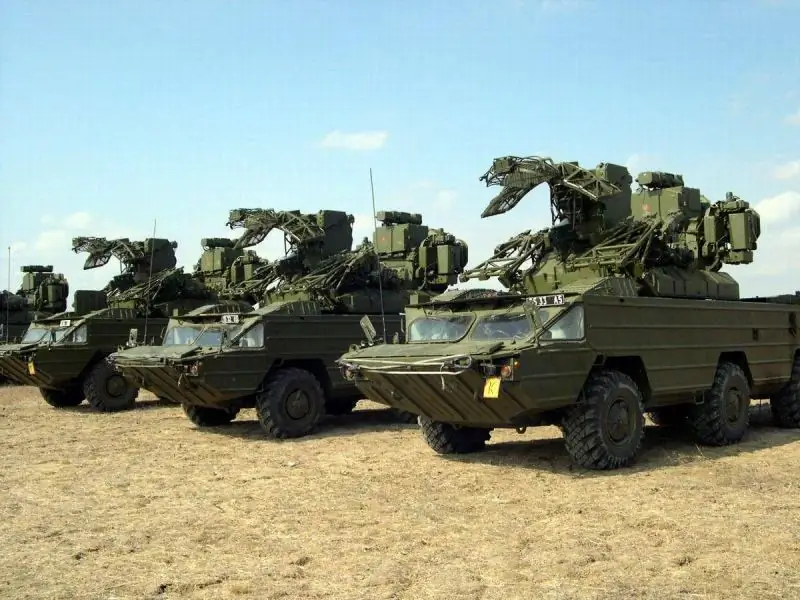- Author Matthew Elmers [email protected].
- Public 2023-12-16 21:49.
- Last modified 2025-01-24 09:17.

Shooting conducted recently by the RF Ministry of Defense proved the effectiveness of using the Osa anti-aircraft missile system produced in the 70s. Parts of the air defense forces demonstrated the Osa anti-aircraft system in action. This complex is the oldest and most widespread in the modern Russian army. "Wasps" entered service with the army of the Soviet Union in 1974. Since then, "Wasp" has served faithfully to our military and sailors. More than 400 such systems are currently on alert. "Wasps" reliably cover ground and surface objects from possible air strikes.
Historical reference
"Wasp" (NATO classification: SA-8Gecko-Gecko) is an automated combined-arms anti-aircraft missile system made in the USSR. The complex is used in all weather conditions and is designed to provide cover for the forces and means of motorized rifle (tank) divisions in all types of combat operations. The development of the complex began in October 1960. According to the decree of the USSR Council of Ministers No. 1157-487 of 1960-27-07, work has begun on the creation of an air defense missile system under the code name "Wasp" (in the process of working out the requirements, this project was temporarily called "Ellipsoid"). The work was carried out sometimes hard, the deadlines were constantly missed. Therefore, by 1962, the development process had not even passed the stage of laboratory experimental verification.
The complex was developed mainly on the basis of NII-20 GKRE under the supervision of chief designer M. M. Kosichkin. The Tushinsky Machine-Building Plant was responsible for the creation of missiles for the complex. The design bureau of compressor engineering at the GKAT worked on the launcher.
The Tushinsky MH did not meet the deadlines, therefore, in September 1964, by the decision of the Central Committee of the CPSU and the USSR Council of Ministers, all work on missiles was assigned to OKB-2, headed by P. D. Grushin. A new date was set for the withdrawal of the air defense system for testing: the spring of 1970. In addition, the post of chief designer of the "Wasp" was taken by V. P. Efremov, and his deputy - I. M. Drize. The wheeled chassis for the Osa air defense missile system was developed at the Bryansk Automobile Plant. In the spring of 1970, the Osa air defense missile system passed planned annual tests. The "Wasp" was put into service 11 years after the start of work on its creation: in October 1971.
The complexes began to actively enter service with the army by 1974. However, in 1989, the production of "Os" completely ceased, but the complex remains the most common in the armed forces to this day. At the beginning of 2008, "Wasp" was recognized as the most numerous means of military air defense in Russia.
The complex is equipped with 4. guided missiles of the 9M33 brand, and modifications "Osa-AK" and "Osa-AKM" - 6th. missiles of the 9M33M2 and 9M33M3 brands, respectively.
Wasp missile shot down Tomahawk
According to the Izvestia newspaper, air defense specialists of the RF Ground Forces demonstrated the capabilities of the Osa anti-aircraft complex. In the course of the conducted exercises, "Wasp" successfully coped with simulators of tactical missiles of the ATACMS system (analogue of the domestic "Iskander") and the famous cruise missile from the United States "Tomahawk" (analogue of our X55). - The exercises were carried out in difficult weather conditions: with a dust storm and heat reaching 50 degrees.
Representative of the RF Ground Forces Viktor Dvoinov: "Units imitating the enemy littered the radio air with interference, despite this the system demonstrated excellent combat qualities."
However, despite the accurate hits, experts doubt the accuracy of the "Wasp" in real combat.
According to Igor Korotchenko, editor of the National Defense magazine, the target missiles used in such exercises do not provide a complete picture of exactly how the original Tomahawk will behave in the event of an attack. At the exercises in Kapustin Yar, the role of the Tomahawk cruise missile was played by one of the very first domestic anti-aircraft systems S-25 Berkut, and the tactical ATACMS was played by the Saman missile.
The military assures that the flight characteristics of these missiles are completely identical to the flight parameters of the American originals. According to a representative of the Ground Forces, it is not at all necessary for the training target to look exactly like a missile of a potential enemy. It is much more important that the target moves at the same speed and trajectory as the original. The spokesman added that data from real flights of Tomahawk cruise and tactical missiles and during their use by NATO forces during operations in Yugoslavia and Iraq were used to program the trajectory of training targets.
"Saman", which imitated ATACMS, had a speed of 600 m / s, and "Wasp" knocked him down 40 seconds after the start. During the exercise, other air defense systems were also tested: transported Buk, Tor, Tunguska, S-300V and portable Igla and Strela-10. By 2020, these complexes should be replaced with new ones: the Tunguska will be replaced by the Pantsir, the Buk by the Vityaz, the S-300 by the S-400. And the "Wasp", it seems, will continue to be on alert and further.






